Have you ever picked up a colorful brochure, flipped through a sleek product catalog, or noticed an eye-catching flyer in your mailbox? Those are all examples of marketing materials for business at work — the unsung heroes behind many successful brands. Whether you’re just starting your own company or looking to improve your current marketing game, understanding these materials is essential. They’re not just pretty papers or digital ads; they’re powerful tools that communicate your brand’s message, build awareness, and connect with customers.
In this article, we’ll dive into the world of marketing materials for business — what they are, the various types you can use, why they’re so important, and how to create them effectively. Along the way, you’ll find examples from well-known companies and practical tips to help you make the most of your marketing collateral.
What Are Marketing Materials for Business?
At its core, marketing materials for business refer to the physical or digital tools companies use to promote their products, services, and brand identity. These materials serve as the bridge between your business and your audience, helping you tell your story, showcase your offerings, and persuade potential customers to take action.
Marketing materials can be tangible, like brochures, business cards, posters, and flyers. Or, they can be digital, such as email newsletters, social media graphics, videos, and websites. Regardless of format, all marketing materials share a common goal: to engage your target market and leave a lasting impression.
Types of Marketing Materials for Business
Businesses have a variety of options when it comes to marketing materials, each suited to different purposes and audiences. Here’s a breakdown of some of the most common types:
Print Marketing Materials
- Brochures and Flyers: Ideal for sharing detailed information about your products or services at events, stores, or through direct mail.
- Business Cards: A compact way to share your contact information and brand identity during networking.
- Posters and Banners: Great for grabbing attention at trade shows, retail locations, or community events.
- Catalogs: Effective for showcasing a wide range of products, particularly in retail and wholesale businesses.
Digital Marketing Materials
- Email Newsletters: Keep your audience informed and engaged with regular updates, offers, and stories.
- Social Media Graphics and Ads: Designed to capture attention quickly and encourage shares, likes, or clicks.
- Videos: A highly engaging format for product demos, testimonials, or brand storytelling.
- Websites and Landing Pages: Your online storefront and primary source of brand information.
Each type has its strengths and is often most effective when combined in an integrated marketing strategy.
The Importance of Marketing Materials for Business
You might wonder why invest so much effort and money into marketing materials? The answer lies in their ability to build trust, establish brand identity, and drive sales.
- Brand Awareness: Consistent and well-designed marketing materials help your brand become recognizable and memorable in a crowded marketplace.
- Professionalism: Using high-quality materials conveys that your business is credible and trustworthy, encouraging customers to engage with you.
- Customer Connection: Through effective messaging and design, marketing materials can emotionally connect with your audience, making them more likely to choose your brand.
- Lead Generation and Sales: Well-crafted materials guide potential customers through the buying process, answering questions and motivating action.
Brands like Apple use sleek product catalogs to highlight innovation and quality, while small businesses might rely on personalized brochures to build community trust.
How to Create Effective Marketing Materials for Business
Creating impactful marketing materials requires a blend of creativity, strategy, and attention to detail. Here are some key tips to get started:
1. Know Your Audience
Understand who you’re targeting. What are their needs, preferences, and pain points? Tailor your message and design accordingly.
2. Consistent Branding
Use your logo, brand colors, and fonts consistently across all materials to reinforce brand identity.
3. Clear Messaging
Keep your content concise, focused, and benefit-oriented. Tell customers how your product or service solves their problems.
4. High-Quality Design
Invest in professional design to ensure your materials look polished and attractive, whether printed or digital.
5. Call to Action (CTA)
Always include a clear CTA, such as visiting your website, calling for a consultation, or redeeming a discount.
Examples of Marketing Materials for Business in Action
Some of the world’s most successful brands excel in using marketing materials to communicate their message effectively:
- Coca-Cola: Their use of vibrant posters and packaging reinforces their brand’s fun and refreshing personality.
- Nike: From digital ads to event banners, Nike’s marketing materials consistently highlight motivation and athletic excellence.
- Amazon: Email newsletters and website banners keep customers informed about deals while reinforcing their customer-first brand promise.

These examples show that regardless of size, businesses can leverage marketing materials to create meaningful connections.
Conclusion: Harnessing Marketing Materials for Business Success
Whether you’re handing out business cards, designing social media posts, or printing flyers, marketing materials for business are crucial tools in your branding and sales toolkit. By understanding their types, importance, and how to create them effectively, you’ll be well-equipped to build brand awareness and grow your customer base.
Start by assessing your current materials, identifying gaps, and thinking about how you can make every piece reflect your unique brand story. Remember, in the world of business, every impression counts — and your marketing materials are often the first step in creating a lasting one.

